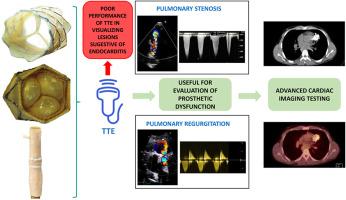Evaluation of prosthetic dysfunction in the diagnosis of endocarditis associated to prosthetic pulmonary valve and pulmonary conduit
IF 1.2
Q4 CARDIAC & CARDIOVASCULAR SYSTEMS
International journal of cardiology. Congenital heart disease
Pub Date : 2025-05-13
DOI:10.1016/j.ijcchd.2025.100591
引用次数: 0
Abstract
Introduction
The number of cases of infective endocarditis associated to prosthetic pulmonary valves and pulmonary conduits (PPVIE) is likely to increase in the future. Transthoracic echocardiography (TTE) presents challenges in visualizing lesions suggestive of endocarditis in these patients. However, TTE may provide additional findings, such as prosthetic dysfunction, which can guide the diagnosis of this condition. The main objective of this study is to analyze prosthetic pulmonary valve dysfunction as an echocardiographic manifestation of PPVIE.
Methods
All cases of PPVIE (definite and possible, according to the modified Duke criteria) at Cruces University Hospital (Baracaldo, Spain) between January 2014 and July 2024 were included. Prosthetic dysfunction was defined as a peak transvalvular gradient (PTG) ≥25 mmHg for homografts and ≥40 mmHg for prosthetic pulmonary valves and bovine pulmonary conduits (stenosis) and/or pulmonary regurgitation (PR) moderate or severe. Number of cases of prosthetic dysfunction between the PPVIE episode and prior to the episode were compared. We analyzed the mechanisms of prosthetic dysfunction in the PPVIE episode.
Results
14 cases of PPVIE were identified. In cases prior to the PPVIE episode, 42.9 % had prosthetic dysfunction, while in the PPVIE episode, 92.3 % had prosthetic dysfunction. Stenosis was a more frequent cause of valve dysfunction than PR.
Conclusions
Prosthetic dysfunction (due to stenosis or regurgitation) is a relevant finding in the diagnosis of PPVIE in cases where lesions suggestive of endocarditis are not visualised. Although not included in the Duke criteria, stenosis is a more frequent mechanism of dysfunction than PR.

假体功能障碍在假体肺瓣膜及肺导管相关心内膜炎诊断中的价值评价
感染性心内膜炎与假肺瓣膜和肺导管(PPVIE)相关的病例数在未来可能会增加。在这些患者中,经胸超声心动图(TTE)在显示提示心内膜炎的病变方面提出了挑战。然而,TTE可能提供额外的发现,如假体功能障碍,这可以指导这种情况的诊断。本研究的主要目的是分析人工肺瓣膜功能障碍作为PPVIE的超声心动图表现。方法收集2014年1月至2024年7月在西班牙克鲁塞大学医院(Baracaldo, Spain)就诊的所有PPVIE病例(确诊和可能符合Duke标准)。假体功能障碍定义为同种移植物的峰值经瓣梯度(PTG)≥25 mmHg,假体肺瓣膜和牛肺导管(狭窄)和/或肺反流(PR)≥40 mmHg,中度或重度。比较PPVIE发作前后假体功能障碍的病例数。我们分析了PPVIE发作中假体功能障碍的机制。结果共鉴定出PPVIE 14例。在PPVIE发作之前的病例中,42.9%的患者有假体功能障碍,而在PPVIE发作期间,92.3%的患者有假体功能障碍。瓣膜狭窄是瓣膜功能障碍更常见的原因。结论在未见心内膜炎病变的情况下,假体功能障碍(由狭窄或反流引起)是诊断PPVIE的一个相关发现。虽然没有包括在Duke标准中,但狭窄是比PR更常见的功能障碍机制。
本文章由计算机程序翻译,如有差异,请以英文原文为准。
求助全文
约1分钟内获得全文
求助全文
来源期刊

International journal of cardiology. Congenital heart disease
Cardiology and Cardiovascular Medicine
自引率
0.00%
发文量
0
审稿时长
83 days
 求助内容:
求助内容: 应助结果提醒方式:
应助结果提醒方式:


